Physical Address
304 North Cardinal St.
Dorchester Center, MA 02124
Given the diverse occupations that people pursue, there are thousands of chemicals and other potentially noxious insults that can impinge on the skin in many different ways . Traditionally, the types of hazardous exposure are categorized as:
mechanical – friction, pressure, vibration, mechanical disruption
chemical – elements and chemical compounds (organic, inorganic, and proteins)
physical – heat, cold, radiation (UV and ionizing)
biological – organisms including viruses, bacteria, fungi, and parasites.
The types of dermatoses induced by exposure to these noxious occupational hazards can be grouped as outlined in Table 16.1 . This chapter differs from most of the others in that it deals with diverse conditions, many of which are also covered in detail in specific chapters.
| CLINICAL CLASSIFICATION OF OCCUPATIONAL DERMATOSES |
| Contact dermatitis |
|
| Chemical burn |
| Contact urticaria |
| Cancer |
|
| Follicular disease |
|
| Autoimmune connective tissue disease |
| Pigmentary disorders |
| Foreign body reactions (see Ch. 94 ) |
| Infection |
|
Occupational disease has existed for thousands of years. Hippocrates (c460–377 BC) hypothesized that there were environmental causes of disease. One of the first written descriptions of occupational dermatoses was by the Italian Bernardino Ramazzini (1633–1714). He described diseases associated with a variety of occupations, including different types of ulcerations in fresh- and salt-water fishermen. During their long-distance voyages in the sixteenth century, Drake and Magellan experienced significant problems from scurvy due to the lack of vitamin C from fresh fruit and vegetables. In 1747, James Lind performed the first controlled trial demonstrating the protective effects of citrus fruits against scurvy. In 1795, the British Navy included lemon juice in ships' stores as one of the earliest forms of prevention for an occupational skin disease.
In a UK household survey, a rate of occupational dermatosis of 15/10 000 for those who had ever been employed demonstrates the high frequency of affected individuals; in comparison, a rate of 5.1/10 000 has been reported by physicians in Denmark and Finland, where occupational disease is notifiable. Of the most common physical illnesses due to occupation, skin diseases (23%) rank second, after musculoskeletal disorders (45%) . In the US in 2010 it was estimated that for private industry, the annual cost of occupational skin disease due to lost productivity, medical care, and disability payments was US$1.2 billion and this accounted for 10.5% of the cost attributed to skin disorders from all causes. The average cost per claim for occupational dermatitis in the 1990s was US$3550 and the period of disability was 24 days . More recently, the German statutory health insurance companies estimated the cost of hand eczema to be €9000 per case with an annual cost of €2,128 .
Based upon classification systems such as the International Standard Classification of Occupations (ISCO), the distribution of occupational skin disease reported by industry varies with the specialty of the physician ( Fig. 16.1 ) . The difference in incidence of neoplasia, as reported by dermatologists compared to occupational physicians, reflects the delay between exposure and development of disease and the fact that the majority of workers have left employment when the cancer develops. Differences in reporting also reflect the distribution of occupational health departments in industry: vehicle assembly, glass and ceramic workers as well as scientific technicians are often seen by occupational physicians, whereas hairdressers, for example, are seen primarily by dermatologists. Over the past decade, there has been a consistent decline in the reported incidence of occupational dermatoses both in the US and in Europe .
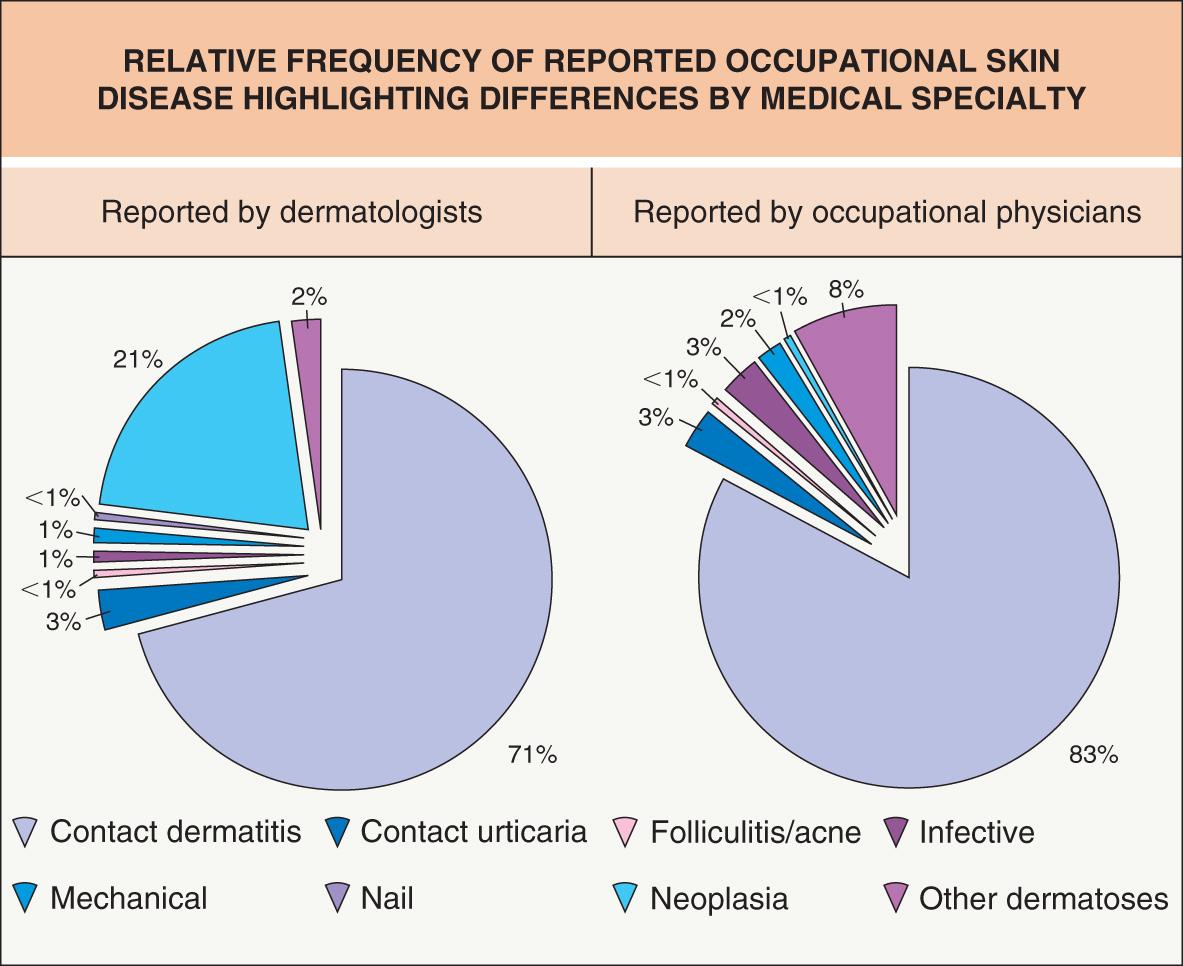
▪ Contact eczema
The most common causes of occupational allergic contact dermatitis are (in order of decreasing frequency): rubber, nickel, epoxy and other resins, and aromatic amines
The most common causes of occupational irritant contact dermatitis are (in order of decreasing frequency): soaps, wet work, petroleum products, solvents, and cutting oils and coolants
Contact dermatitis accounts for the majority of occupational skin disease that predominantly affects the hands. The prevalence of hand dermatitis in the population has been estimated at approximately 0.5%, rising in some studies to 10% when an industrial workforce has been examined. While most individuals will remain at work, over half will change jobs and a large proportion will be absent from work for a month or more.
In the first century AD, Pliny the Younger recorded dermatitis in individuals after they cut down pine trees, presumably representing allergic contact dermatitis to colophony in pine resin. Ramazzini in his 1700 treatise described irritant contact dermatitis of the hands and forearms in soap and laundry workers.
An age-related increase in rates of occupational dermatitis is seen in men, but in women the peak age of incidence is 16–29 years with a decline thereafter. However, a comparison of rates by age within specific occupational groups suggests that the sexes follow a similar pattern. Among chefs and cleaners of either sex, higher rates are seen in young workers, whereas rates among machine tool operators increase with age, reflecting the type of occupational exposure. Materials giving rise to contact dermatitis in the UK are shown in Figure 16.2 , and the highest risk UK occupations in Figure 16.3 . In contrast to the UK, in Finland and the US, the highest rate of skin disease is among agricultural workers.
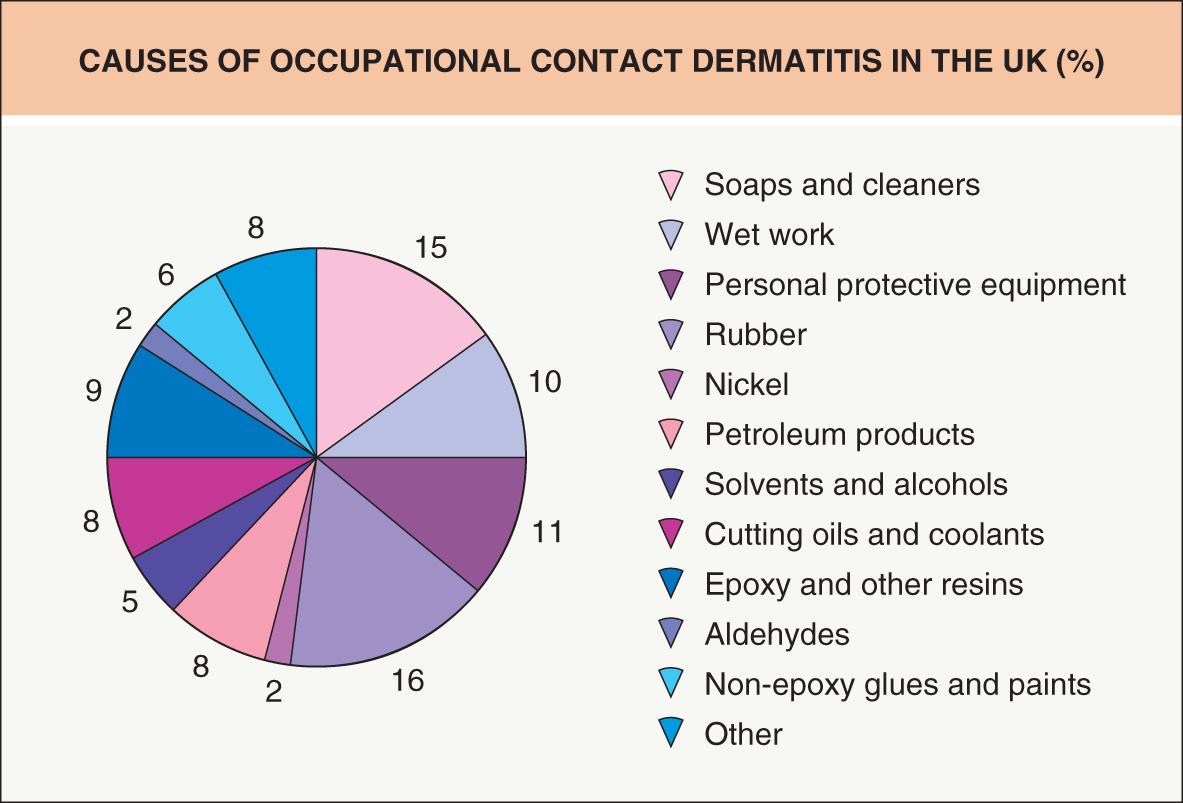

The initial events of both irritant and allergic contact dermatitis (see Chs 14 & 15 ) are similar. Depending upon the severity of the insult, the tissue response can reach a level at which it becomes clinically apparent as cutaneous inflammation ( Fig. 16.4 ). If tissue perturbation is maintained via repeated insults, then chronic dermatitis ensues, while an early withdrawal of the insult may result in healing.
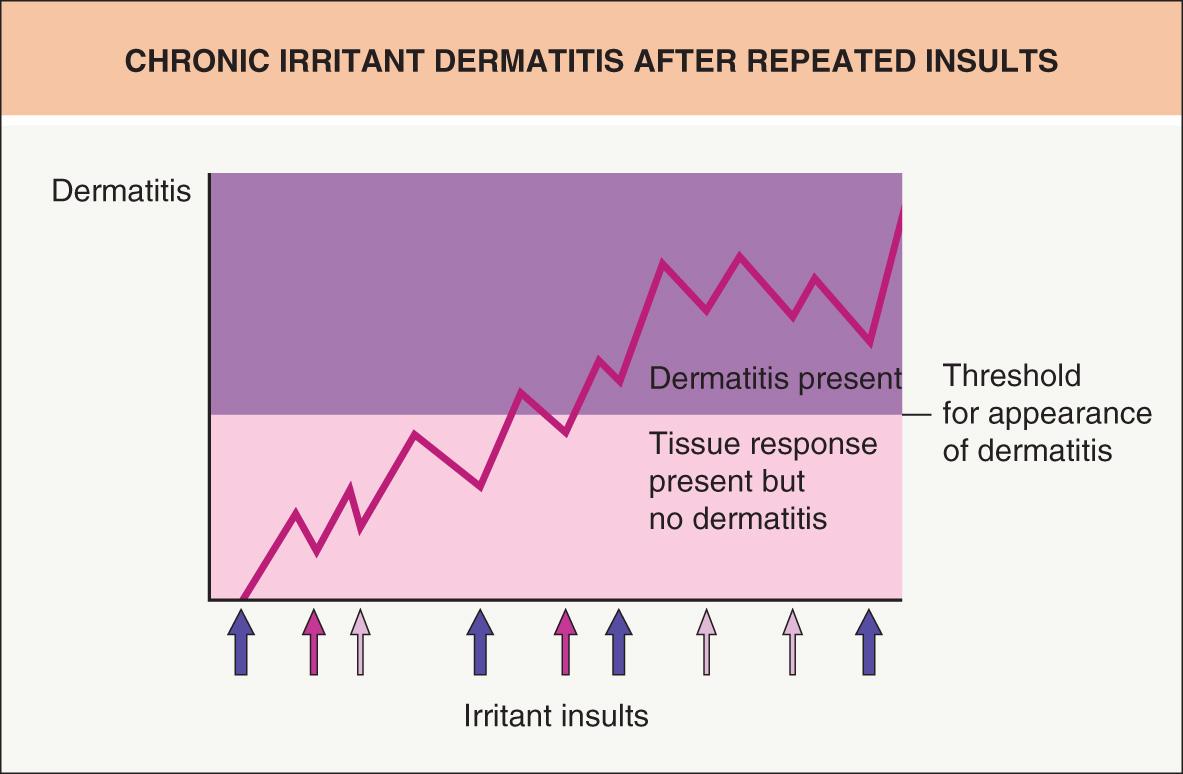
Contact dermatitis, both allergic and irritant, is morphologically indistinguishable from endogenous eczema ( Fig. 16.5 ). Although most cases of dermatitis will result from direct exposure that leads to localized dermatitis, there are other routes of absorption that can lead to dermatitis. In the case of solvents, inhalation may result in widespread dermatitis, often with systemic involvement.
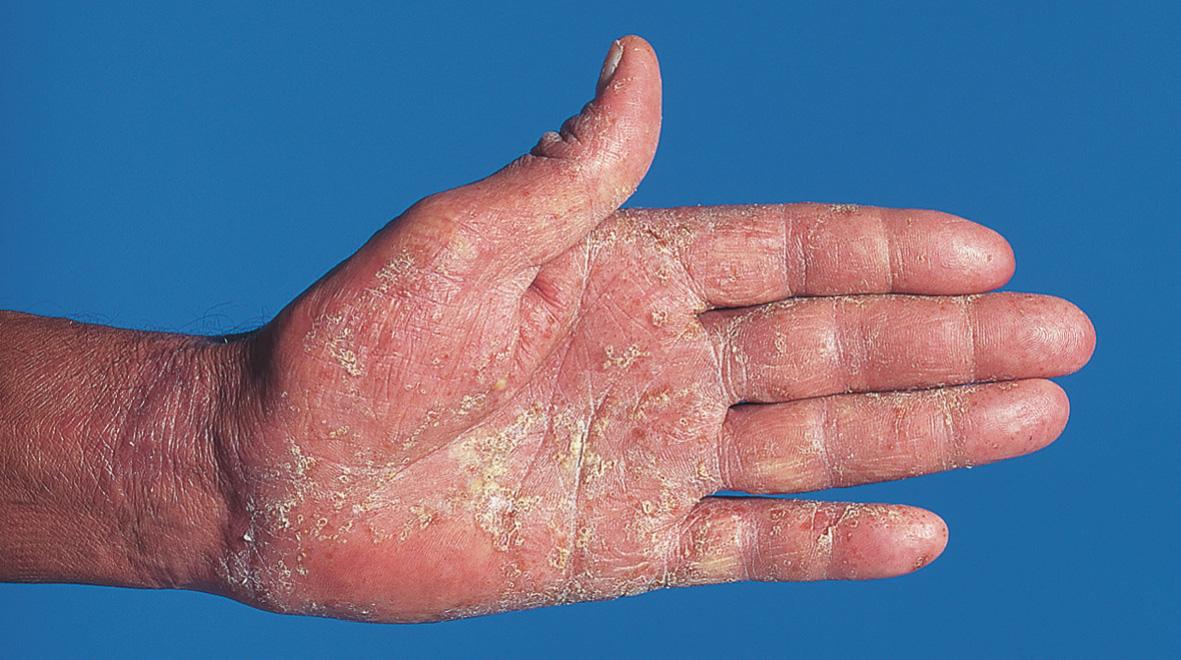
Diagnosis of an occupational cause is dependent on a thorough dermatologic and occupational history ( Table 16.2 ), combined with examination of the entire skin. Material safety data sheets (MSDS) provide a guide to the nature of materials handled at work. They list the chemical composition and the hazards associated with the product, e.g. irritant, corrosive, contains a sensitizer. However, total reliance should not be placed on the MSDS as they may not list all ingredients of relevance, and communication with the manufacturer may prove helpful. When occupational dermatitis is suspected but a cause cannot be established from the history, a workplace visit may prove invaluable and may also elucidate the source of an allergen previously detected via patch testing.
| POINTS TO CONSIDER WHEN TAKING AN OCCUPATIONAL HISTORY | |
|---|---|
Primary (initial) site of disease
|
In 90%, it is the hands Is this consistent with work exposure as a cause? Does time off result in improvement? |
| Materials handled | |
|
Irritant, corrosive, or sensitizing Suggests an irritant contact dermatitis Is it appropriate? Is there an allergy to personal protective equipment? |
| Previous skin disease or history of atopy | Is this a recurrence of a previous problem? |
| Known allergies | Is there unrecognized exposure? |
| Treatment | May cause allergic contact dermatitis |
| Hobbies | May be a more likely cause than occupation |
Although the primary site is usually the hands, spread to adjacent areas of skin (even without primary contact) is relatively common. Spread to distant sites, such as the face and feet, is more frequently seen in allergic contact dermatitis than in irritant contact dermatitis. Notably, airborne allergens, e.g. from paint sprayers, can lead to a pattern of dermatitis that suggests this type of exposure. Covered areas such as the trunk and feet are unusual sites of onset of disease. Improvement of the dermatitis during periods away from work is an important clue to an occupational cause, but it should be remembered that endogenous eczema may also be exacerbated by workplace exposures. As the dermatitis becomes chronic, the relationship between work and exacerbations becomes less clear-cut.
Patch testing is essential for establishing the diagnosis and should be performed in any individual with a dermatitis that may be work-related or for whom a change of job is being contemplated. Testing with work materials is essential ( Table 16.3 ) if contact allergy is not to be missed, as not all allergens are commercially available and the MSDS may not disclose all relevant ingredients. A guide to testing 4350 chemicals and an update have been published . When a reaction occurs to an unknown substance, the use of a dilutional series and the testing of approximately 20 controls can confirm that the reaction is allergic rather than irritant.
| SUGGESTED CONCENTRATIONS FOR PATCH TESTING SELECTED WORK MATERIALS | ||
|---|---|---|
| Sample | Dilution | Occupation(s) |
| Personal care products | ||
|
As is | Hairdresser/beautician |
|
1–5% aqueous or open † | Hairdresser/beautician |
| Plants ‡ | ||
| Bulb, leaf, flower | As is | Gardener/florist Agriculture/vegetable processing |
| Woods – sawdust | As is/10% petrolatum | Joiner/woodworker |
| Dyes (clothing) | 1% petrolatum | Textiles |
|
As is – moistened | |
| Foods § | As is | Catering/chef |
| Glue | 10% aqueous/ petrolatum | Various |
|
1% petrolatum | Dentist/orthopedic surgeon |
|
0.1% petrolatum | |
|
1% petrolatum | Painter – 2-part paints |
|
0.1% petrolatum | |
| Ink | As is | Printing |
|
1% petrolatum | |
| Oil | ||
|
10% aqueous or open | Metal machining |
|
As is | Various-use machinery |
| Paint | 10% aqueous/ petrolatum | Painter/decorator |
| Photographic chemicals | 10% aqueous | Photographer |
| Solvents/thinners | 10% acetone | Various |
† Open test: apply the substance to a 3 cm diameter area of skin and allow to dry. Read as normal but do not occlude.
‡ Do not test unless the plant has been identified and is recognized not to be irritant. There may be a risk of sensitization.
In an extensive surveillance report, the most common causes of occupational allergic contact dermatitis were rubber (23.4% of cases), nickel (18.2%), epoxy and other resins (15.6%), aromatic amines (8.6%), chromate (8.1%), fragrances and cosmetics (8.0%), and preservatives (7.3%) .
Most occupational dermatitis results from repeated exposures to weak irritants which cause cumulative damage to the skin (see Fig. 16.4 ). On the other hand, strong irritants are usually recognized and protection provided. Employees with previous atopic dermatitis, especially with hand involvement, are particularly at risk, as are those with mutations in the filaggrin gene .
Soaps (22% of cases), wet work (20%), petroleum products (9%), solvents (8%), and cutting oils and coolants (8%) are the most frequently cited causes of occupational irritant dermatitis .
A chemical burn is an acute irritant reaction in which the injury to the skin is irreversible and cell death occurs. It can occur following a single exposure. Initial symptoms consist of burning and stinging with progressive development of erythema, blisters, erosions and ulceration. Symptoms usually develop in close association with the exposure, but some chemicals, such as phenols and weak hydrofluoric acid, can have a delayed onset. Common occupational causes include :
strong acids: e.g. sulfuric, nitric, hydrochloric, chromic. Most coagulate skin proteins and as a result form a barrier that impedes further penetration. Hydrofluoric acid differs in that it causes a liquefactive necrosis: penetration, even down to bone, can continue for several days after exposure. Pain, which can last several days, is typical of hydrofluoric acid and other fluorides. If more than 1% of the body surface area is affected, systemic toxicity can develop
strong alkalis: e.g. sodium, calcium, and potassium hydroxides; wet cement ( Fig. 16.6 ); sodium and potassium cyanides. Degradation of lipids and saponification of the resulting fatty acids form soaps which aid the penetration of alkalis deeper into the skin. As a consequence, damage is more severe than with most acids (apart from hydrofluoric acid) and pain is also a feature
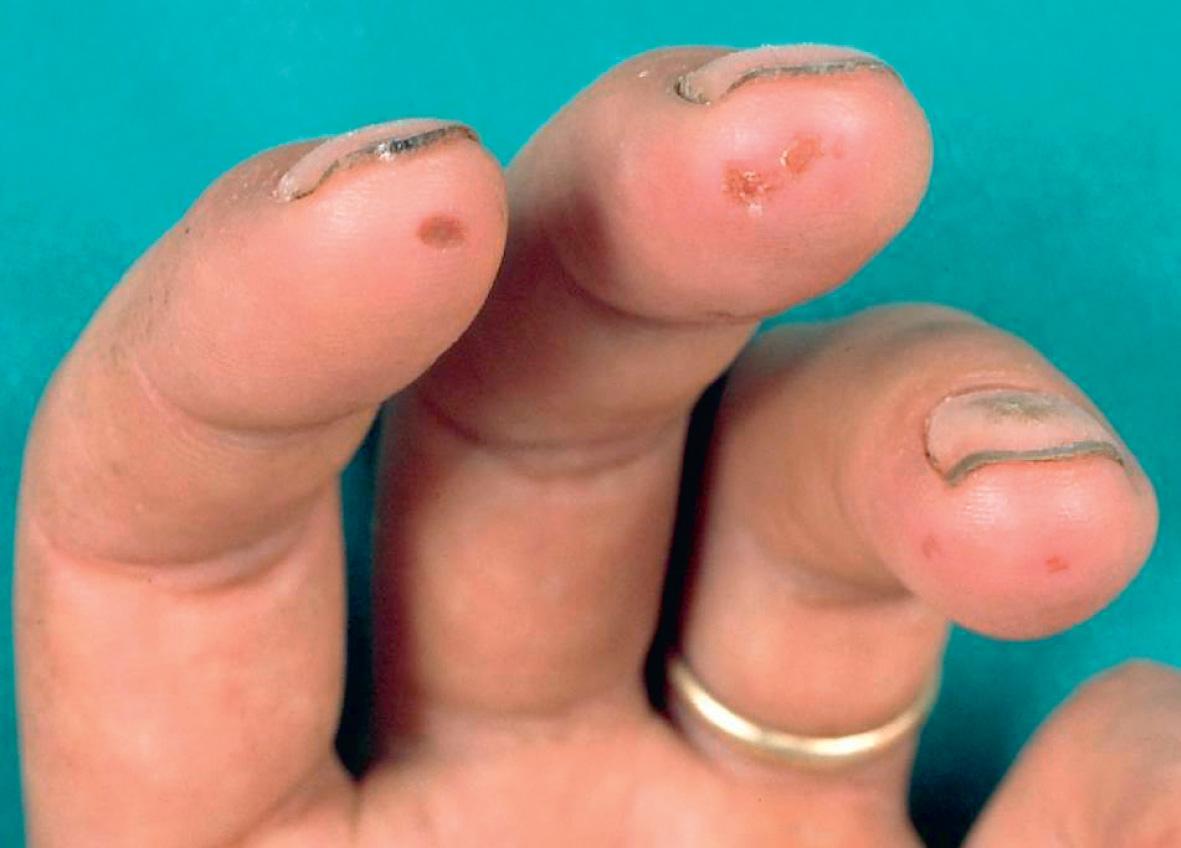
organic and inorganic chemicals: e.g. dichromates; arsenates; phenolic compounds. Phenols and unhardened phenolic resins easily penetrate the skin. Nerve damage may cause anesthesia, but rarely in the absence of visible skin damage. Vasoconstriction may contribute to the necrosis that develops and, following systemic absorption, shock and renal damage may ensue
solvents and gases: e.g. acrylonitrile; ethylene oxide; carbon disulfide; mustine. Ethylene oxide gas is used to sterilize medical instruments, textiles and plastic materials, and it can remain on these items for several days if not allowed to evaporate off prior to use. The possibility of exposure may therefore not be obvious.
Glass fibers are subdivided into various types, depending on fiber diameter, and are used for their insulating (thermal, acoustic, and electrical), strengthening, and filtering abilities. They are chemically inert and the mechanism of skin injury is via direct penetration, which is directly proportional to the diameter (>3.5 microns) of the fiber and inversely proportional to its length. Histologically, eczematous changes including spongiosis are seen.
Pruritus and tingling are the usual initial symptoms of fiberglass dermatitis. Subsequently, erythematous papules develop (often with follicular accentuation), either on exposed areas when there is airborne exposure or on the forearms when there is contamination of a work surface ( Fig. 16.7 ) . Contamination of clothing leads to involvement of sites where there is close contact with the skin, particularly flexural areas. Paronychia is common, and airborne exposure may also cause burning eyes, sore throat, and cough.
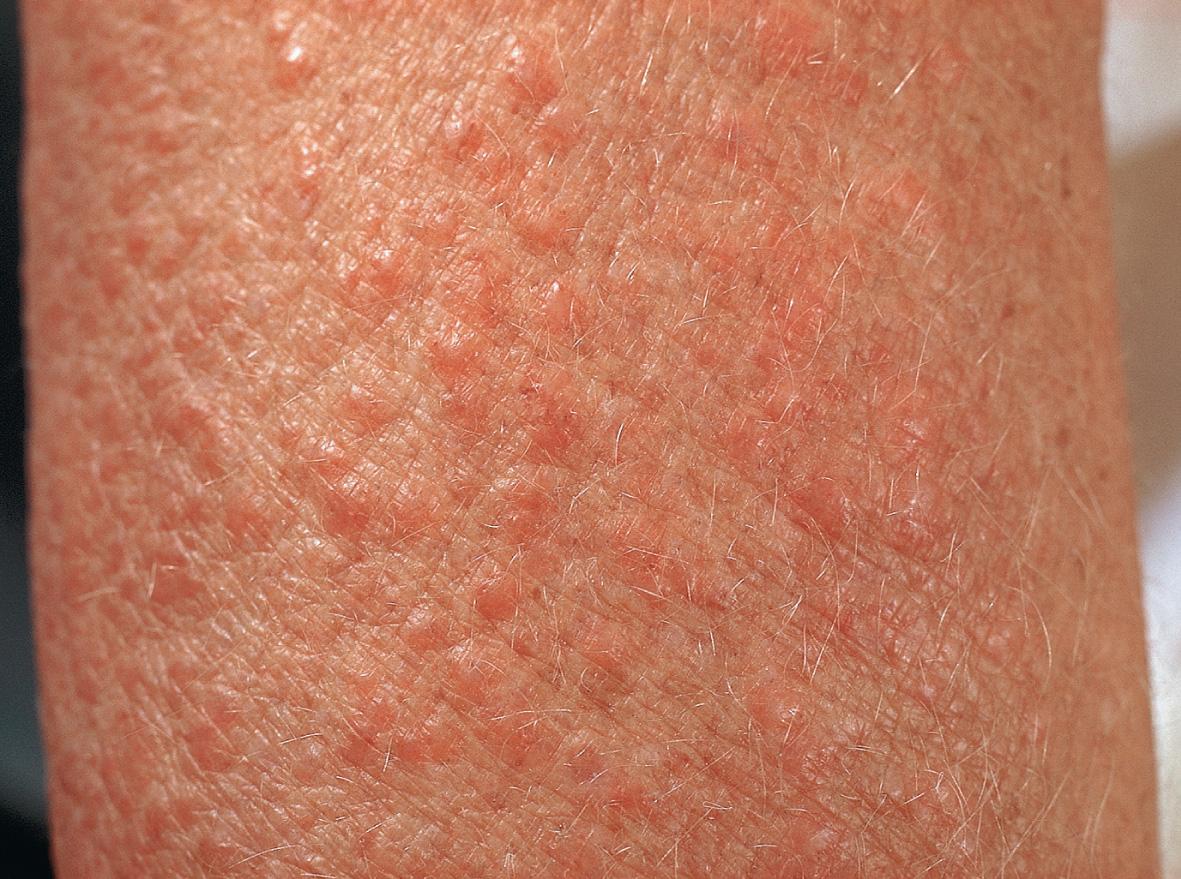
The diagnosis is often based on clinical findings, but can be confirmed by detecting the glass fibers either by tape stripping affected skin or by examining skin scrapings in 20% potassium hydroxide. The dermatitis resolves rapidly after cessation of exposure. In most individuals, hardening occurs and symptoms resolve over a few weeks despite continued exposure; of note, the use of resins to bind glass fibers can result in an allergic contact dermatitis.
Most occupational photosensitivity is phototoxic in nature and resolves with hyperpigmentation. The most common scenario consists of outdoor workers exposed to plant-derived psoralens. This may result from direct contact or be airborne as in “strimmer” dermatitis when plant sap splatters the body of a worker inadequately protected when cutting down plants (see Ch. 17 ).
Coal tar and its products, including creosote, can cause a reaction known as tar/pitch smarts. A burning or stinging sensation develops after as little as 15 minutes of sun exposure.
Occupational marks are usually areas of lichenification or calluses and corns that develop at sites of friction and are specific to a particular job ( Fig. 16.8 ). Mechanical injury to the skin is also thought to cause dermatitis analogous to irritant chemical damage. It may result in a keratotic hand dermatitis or post-traumatic eczema (Koebner phenomenon).
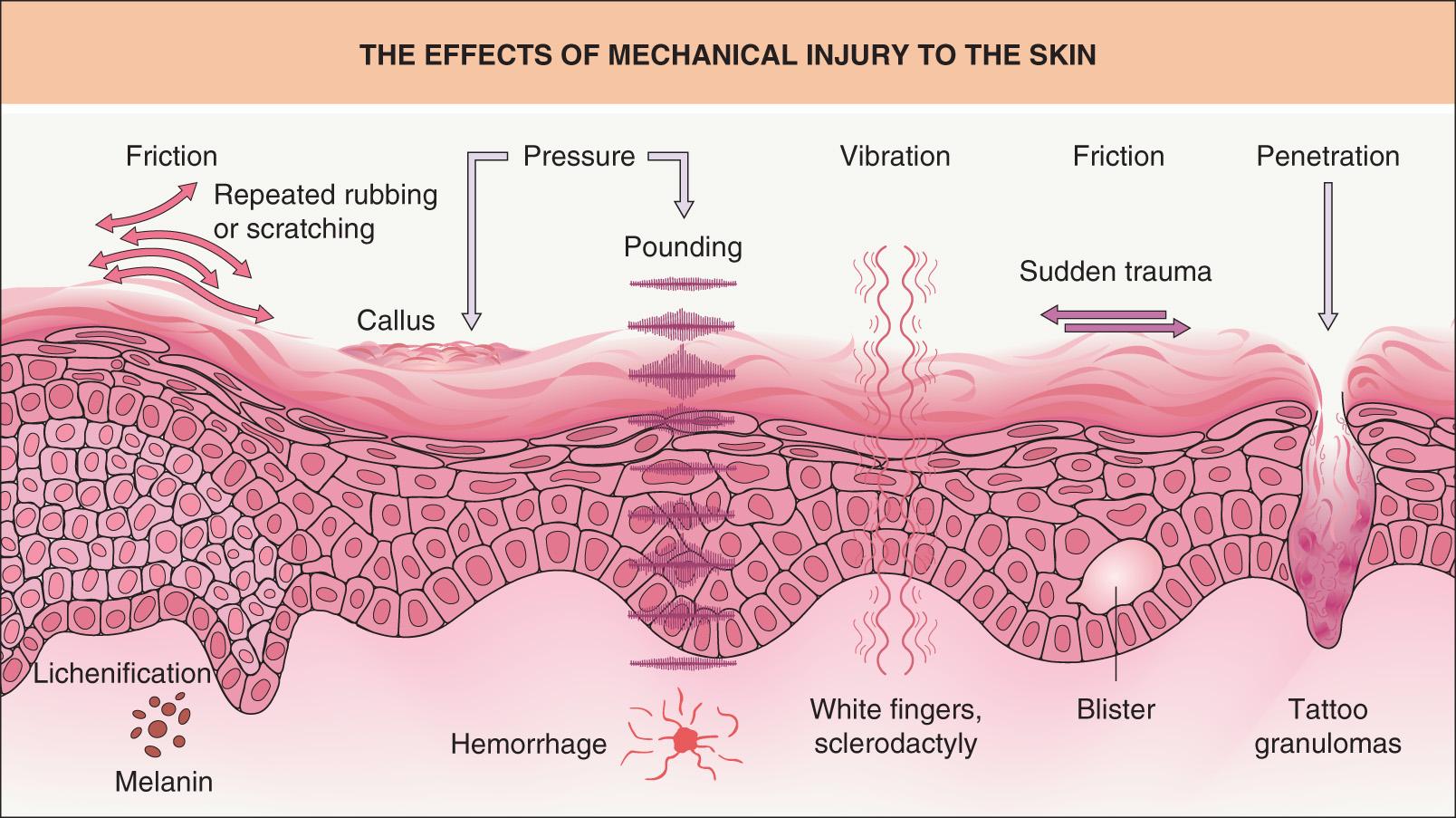
The histologic features of allergic contact dermatitis and irritant contact dermatitis are discussed in Chapters 14 and 15 , respectively.
The etiology of occupational dermatitis is frequently multifactorial and coexisting endogenous eczema may contribute to the clinical appearance. Tinea manuum may resemble hand dermatitis, especially following treatment with topical corticosteroids, and scabies infestation of the interdigital spaces can simulate irritant dermatitis. Rarely, blistering of the dorsal hands due to porphyria cutanea tarda is misconstrued as contact dermatitis.
Psoriasis frequently affects the palms, resulting in keratotic plaques, sometimes with fissures. This can be difficult to distinguish from dermatitis when there are no lesions elsewhere. Furthermore, psoriasis may be exacerbated by repeated, work-related trauma leading to Koebner phenomena. Nail involvement and plaques over the interphalangeal joints are helpful clues.
Occupational disease prevention is divided into primary, secondary, and tertiary measures ( Table 16.4 ) . During pre-employment screening, a history of severe childhood atopic dermatitis, particularly with hand involvement, indicates an individual at risk of developing dermatitis from exposure to irritants. Employment in a “dry” job should be recommended. In the workplace, the use of protective equipment and skin care preparations should be encouraged ( Table 16.5 ). Use of protective creams prior to exposure may aid in the subsequent removal of irritants and application of emollients throughout the day may prevent the development of dermatitis. Education of the workforce in skin care has been shown to reduce the development of skin disease .
| HIERARCHY OF OCCUPATIONAL DISEASE PREVENTION | |
|---|---|
| Primary prevention | Avoid disease onset
|
| Secondary prevention | Detect presymptomatic or early disease
|
| Tertiary prevention | Treatment of active disease
|
| GUIDELINES AIMED AT PREVENTING CONTACT DERMATITIS | ||
|---|---|---|
| Advice | Explanation | |
| Do not wear rings |
|
|
| Hand washing |
|
|
|
||
| Wear gloves |
|
|
|
|
|
|
|
|
|
|
|
| Use moisturizer |
|
|
|
|
|
|
|
|
| For antisepsis |
|
|
| Follow the same advice at home |
|
|
Treatment is discussed in Chapters 14 and 15 . The most important aspect, however, is avoidance of the cause. Ideally, a change in the production process may avoid the need for exposure, but this may not be feasible. A practical compromise is the use of personal protective equipment and/or substitution of a particular chemical. Advice on appropriate glove type may be found on the MSDS or from glove manufacturers (e.g. www.ansellpro.com ). Gloves need to be replaced regularly and each particular type of glove will have a penetration time for any given chemical. For example, acrylate glues (orthopedic surgeons, dentists), the hair dye para-phenylenediamine (hairdressers), and “acid perm” solutions containing glycerol monothioglycolate (hairdressers) rapidly penetrate latex gloves.
Initial treatment of chemical burns requires irrigation with large volumes of water. When the chemical is insoluble in water, a soap solution may be used instead. High pressures should not be used, in order to avoid splashing other areas of the body or bystanders with the corrosive material. For some chemicals, specific antidotes can then be used, e.g. 2.5% calcium gluconate gel for hydrofluoric acid; reduction of pain is a sign of successful treatment. When there is a risk of toxicity from systemic absorption, as with chromic acid, early debridement of necrotic areas reduces blood levels.
Several chemicals (e.g. hydrofluoric acid, phenolic compounds, chromic acid, gasoline) carry a significant risk of systemic toxicity even when the area of skin involved is small (approximately 1% of body surface area). In these instances, regular monitoring of blood, liver and kidney function plus appropriate supportive treatment (e.g. dialysis) is required. When the chemical is also a sensitizer, allergic contact dermatitis may subsequently appear on re-exposure to non-irritant concentrations, as burns and irritant dermatitis promote sensitization.
Once it has developed, the outlook for occupational contact dermatitis is poor , and patients frequently have persistent disease despite interventions. While a change of occupation is associated with a better prognosis, the possibility exists that the new workplace will have the same or similar chemical exposures. Prognosis is also worse when there is a contact allergy (delayed or immediate) to a chemical that is present in the domestic as well as the industrial environment. Some individuals (~10%) have persistent disease in the absence of any obvious cause, for which the term “persistent post-occupational dermatitis” has been coined.
▪ Contact urticaria syndrome ▪ Immediate contact reaction ▪ Protein contact dermatitis
Pruritus and wheal-and-flare reaction
Develops within 60 minutes of exposure and resolves within 24 hours
The protein content of latex rubber is responsible for the associated contact urticaria
In suspected cases of latex-induced contact urticaria, the specific IgE test may be negative, requiring prick testing with a commercial latex extract and a usage test
Become a Clinical Tree membership for Full access and enjoy Unlimited articles
If you are a member. Log in here